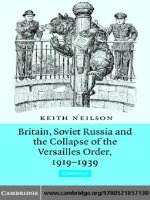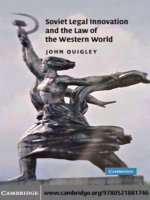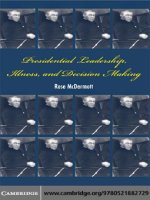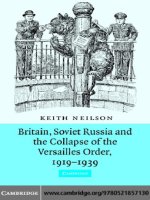0521827892 cambridge university press congress progressive reform and the new american state apr 2004
Bạn đang xem bản rút gọn của tài liệu. Xem và tải ngay bản đầy đủ của tài liệu tại đây (1.65 MB, 311 trang )
This page intentionally left blank
Congress, Progressive Reform, and the New American State
This study contributes to the ongoing attempt to trace the lineage of
the modern American state. An understanding of the dynamics of state
building requires attention to the progressive reform movements that
influenced American politics during the early twentieth century and to
the congressional decision-making process out of which the new governing institutions emerged. Congress, Progressive Reform, and the New
American State provides detailed case studies of congressional legislation relating to railroad regulation, labor relations, and social policy
and analyzes party and faction divisions in the House and Senate. It
finds evidence of a fairly cohesive movement on the part of Congressmen from the South and Midwest to extend the regulatory powers of the
federal government. However, many congressional progressives had serious reservations about the creation of powerful, partially autonomous
regulatory agencies, and at key points their misgivings weakened the reforming impetus. Moreover, in rebelling against the disciplines of party
government, the progressives themselves damaged the major source of
central direction in congressional policymaking. Progressive reform undermined the system of party government without displacing it, ensuring that the modern American state would be a hybrid structure in
which newer forms of governance coexisted with elements drawn from
the older “state of courts and parties.”
Robert Harrison is a Lecturer in History at the University of Wales,
Aberystwyth, where he teaches history and American studies. His most
recent book is State and Society in Twentieth-Century America, and he
has published articles in several journals, including the Journal of Urban
History and American Nineteenth Century History.
Congress, Progressive Reform, and
the New American State
ROBERT HARRISON
University of Wales, Aberystwyth
cambridge university press
Cambridge, New York, Melbourne, Madrid, Cape Town, Singapore, São Paulo
Cambridge University Press
The Edinburgh Building, Cambridge cb2 2ru, UK
Published in the United States of America by Cambridge University Press, New York
www.cambridge.org
Information on this title: www.cambridge.org/9780521827898
© Robert Harrison 2004
This publication is in copyright. Subject to statutory exception and to the provision of
relevant collective licensing agreements, no reproduction of any part may take place
without the written permission of Cambridge University Press.
First published in print format 2004
isbn-13
isbn-10
978-0-511-19452-8 eBook (EBL)
0-511-19452-8 eBook (EBL)
isbn-13
isbn-10
978-0-521-82789-8 hardback
0-521-82789-2 hardback
Cambridge University Press has no responsibility for the persistence or accuracy of urls
for external or third-party internet websites referred to in this publication, and does not
guarantee that any content on such websites is, or will remain, accurate or appropriate.
Contents
List of Tables
Preface
Acknowledgments
Abbreviations
1
2
3
4
5
6
7
8
9
Introduction
Congress and the Nation
The Troubled Subject of Railroad Regulation in the
Progressive Era
Congress and the “Labor Question”
page vi
ix
xi
xiii
1
13
50
97
The Ideal of a “Model City”: Congress and the District of
Columbia
The Senate and Progressive Reform
125
156
Patterns of Republican Insurgency in the House of
Representatives
Progressivism, Democratic Style
Congress, Progressive Reform, and the New American State
192
229
255
Appendix: The Analysis of Roll Calls
Index
277
281
v
Tables
2.1
2.2
2.3
2.4
3.1
3.2
3.3
3.4
3.5
4.1
4.2
5.1
6.1
6.2
6.3
6.4
7.1
7.2
7.3
7.4
7.5
vi
Characteristics of Members of the House of
Representatives, 59th Congress
page 14
Trends in the Turnover of House Membership, 1861–1921
16
Chairmen of Major House Committees, 59th Congress
26
Characteristics of U.S. Senators, 59th Congress
29
Senate Roll Calls on the Hepburn Bill
72
Voting of Republican Senators on the Teller Amendment
to the Hepburn Bill
73
Senate Voting on the Hepburn Bill
76
Senate Roll Calls on the Mann-Elkins Bill
88
Senate Voting on the Mann-Elkins Bill
89
Republican “Friends of Labor,” 1906
105
Republicans Voting to Exempt Labour Organisations
from Prosecution under the Antitrust Law, 1910
121
Voting on the District of Columbia Playground
Appropriation, 60th Congress
136
Classification of Senate Roll Calls, 59th and 60th
Congresses
158
Votes of Republican Senators on Scale Items, 59th and 60th
Congresses
160
Voting of Selected Republican Senators on the Payne-Aldrich
Tariff Bill
177
Votes of Republican Senators on Scale Items, 61st Congress
182
Classification of House Roll Calls, 59th and 60th
Congresses
199
Votes of House Republicans on Scale Items, 59th and 60th
Congresses
201
Republican Advocates of Rules Reform, 60th Congress
208
Republican Advocates of Rules Reform, 61st Congress
212
Classification of House Roll Calls, 61st Congress
215
List of Tables
7.6
8.1
8.2
Votes of Republican Congressmen on Scale Items,
61st Congress
Voting of Senate Democrats and Republican Insurgents
on the Payne-Aldrich Tariff
Democratic Voting on D.C. Playground Appropriations
in the House of Representatives, 1909–1910
vii
221
236
245
Preface
“Please send me a few of those publications that are printed by the Government,” a constituent in search of free reading matter asked his Congressman. “I particularly want some of those eloquent eulogies that are delivered
in Congress, because I dearly like to read about a dead Congressman.”1
It is to be hoped that the readers of this book will share at least some of
that gentleman’s fascination with the behavior of dead Congressmen. It may
seem that another element in the title, progressive reform, is, as a historiographical quantity, hardly less moribund than the honorable gentlemen over
whom valedictory addresses were read on the floor of the House of Representatives. What twenty or thirty years ago was a veritable historiographical
boom area has become a kind of ghost town as the vein of scholarship dried
up and historians moved on to other, seemingly more profitable, seams. But
the territory is not deserted. Its abandonment by historians leaves it open
to exploitation by historically minded political scientists interested in such
questions as electoral realignment, congressional “modernization,” the politics of regulation and the creation of the twentieth-century American state.
While they do not always use the term, the subjects of their investigations are
essentially aspects of what was once called “progressivism,” albeit a rather
spectral variety divorced from its corporeal historical context.
The thematic cement for Congress, Progressive Reform, and the New
American State is formed by combining an older discussion of the character of twentieth-century American liberalism with a newer interest in the
process of state making. By investigating critical episodes in the formation
of the early twentieth-century American state it attempts to breathe new life
into the hoary concept of progressivism. At the same time, through a close
examination of progressivism in a national context it seeks to illuminate the
conditions under which the foundations of the new American state were laid.
This project is founded on the assumption that bringing together these two
1
New York Times, 23 December 1905.
ix
x
Preface
separate discourses is beneficial to both and that this objective can be best
achieved through an investigation of progressive reform in the national
Congress.
Many debts were incurred in the course of this project. Little could have
been accomplished without the support of my colleagues in the Department of History and Welsh History at the University of Wales, Aberystwyth,
who over many years have maintained a congenial and supportive atmosphere. In particular, I would like to thank successive Heads of Department,
Rhys Davies, John Davidson, and Aled Jones, for their encouragement, sympathy, and sometimes patience. I am indebted for financial assistance for
research trips and the purchase of microfilms to the Leverhume Foundation, the British Academy, and the Senate Research Fund of the University
of Wales. Staff at numerous libraries and archives facilitated my access to
research materials, including in particular the Manuscript Division of the
Library of Congress; the State Historical Society of Wisconsin; the Historical Society of Minnesota; the Historical, Memorial and Art Department of
Iowa; the Massachusetts Historical Society; the Sterling Library at Yale; and
the Washingtoniana Room of the Martin Luther King Memorial Library,
Washington, DC. I am grateful in particular to the Inter Library Loan staff
at the University’s Hugh Owen Library for helping me to overcome the locational disadvantages of living in Aberystwyth.
Most of all I owe a continuing debt to my family, to my wife Jean, and
my sons Matthew and Stephen, who through their sometimes startling indifference to early twentieth-century American political development did their
best to keep my feet on the ground.
Acknowledgments
Chapter 5 is a revised version of “The Ideal of a Model City: Congress and
the District of Columbia, 1905–1909,” Journal of Urban History 15 (1989):
435–463. I am grateful to Sage Publications Inc. for their kind permission
to reproduce this article. Portions of this book draw on material published
earlier in my State and Society in Twentieth-Century America published by
Addison Wesley Longman Limited, 1997, and I am grateful to Pearson
Education Limited for permission to make use of this work.
xi
Abbreviations
BDAC
C.R., 59.1 (etc.)
ANB
ISDHA
LC
NA
MasHS
METRP
MinHS
SGL
SHSW
SLYU
Biographical Directory of the American Congress,
1789–1911 (Washington: Government Printing Office,
1913)
Congressional Record, Fifty-ninth Congress, 1st Session
John A. Garraty and Mark C. Carnes, eds., American
National Biography (24 vols., New York: Oxford
University Press, 1999)
Iowa State Department of History and Archives
Library of Congress
National Archives
Massachusetts Historical Society
Microfilm Edition of the Theodore Roosevelt Papers,
Library of Congress
Minnesota Historical Society
Samuel Gompers Letterbooks, American Federation of
Labor Papers, Series 11: Files of the Office of the
President, Library of Congress
State Historical Society of Wisconsin
Sterling Library, Yale University
xiii
Congress, Progressive Reform, and the
New American State
1
Introduction
The British novelist H. G. Wells visited Washington, “full of expectations and
curiosities,” in 1906, during the course of the lengthy Senate deliberations on
the Hepburn rate bill. What appeared to confront him as he sat attentively in
the visitors’ gallery was a scene of unmitigated confusion. While one member
spoke, his colleagues wrote letters, noisily rustled newspapers, stood around
in “audibly conversational groups,” walked carelessly between the speaker
and the Chair, and occasionally summoned pages by loudly clapping their
hands. The galleries were filled with “hundreds of intermittently talkative
spectators.” “The countless spectators, the boy messengers, the comings and
goings kept up a perpetual confusing bafflement. . . . I have never seen a more
distracted legislature.” The disorderly scene that he witnessed in the Senate
chamber seemed to reflect more fundamental defects in the American constitutional framework and in the organization of Congress itself: “The plain
fact of the matter is that Congress, as it is constituted at present, is the
feeblest, least accessible, and most inefficient central government of any civilized nation in the world west of Russia. Congress is entirely inadequate to
the tasks of the present time.”1
Wells’s negative assessment was shared by other European commentators.
Writing a few years earlier, the Russian political scientist Moisei Ostrogorski
commented that Congress “does not initiate great measures, it does not solve
the problems, the solution of which is demanded by the life of the nation.”
Likewise, James Bryce, in the 1910 edition of The American Commonwealth,
noted that Congress made little effort to guide and illuminate its constituents.
“It is amorphous, and has little initiative.”2 Frustration with the national
legislature was expressed by many Americans, not least those that were
1
2
H. G. Wells, The Future in America (new edn., London: Granville, 1987), 177 and 181–3.
Moisei Ostrogorski, Democracy and the Organization of Political Parties (2 vols., London:
Macmillan, 1902), 2:542–6; James Bryce, The American Commonwealth (2 vols., London:
Macmillan, 1910), 1:304.
1
2
Congress, Progressive Reform, and the New American State
professionally obliged to deal with it, like Theodore Roosevelt, who at a
White House dinner late in his presidency expressed a desire to turn sixteen
lions loose on its members.3
Such dismissive comments came easily enough both to executive officers
and scholarly observers. Yet they ignore a great deal of constructive legislation produced during this period. Roosevelt himself, a few years earlier, had
gladly commended Congress for “the literarily phenomenal amount of good
work” that it had performed.4 The seemingly chaotic process which Wells
witnessed in the Senate chamber eventuated in the passage of the Hepburn
Act, which did more than almost any other statute to shape the pattern of
federal supervision of the railroads and, indeed, the structure of the modern
American regulatory state, as well as pure food and meat inspection legislation of comparable significance. That the resulting legislation, like the
regulatory framework that it engendered, was seriously flawed can only partially be attributed to the institutional inadequacies of Congress itself; the
outcome had a great deal to do with the difficulty of reconciling contesting interests and ideologies and the dynamics of party competition. Nonetheless,
we cannot hope to understand the nature of the new American state that
emerged from the Progressive Era without appreciating the role of Congress
in creating it.
Progressivism and the New American State
As social scientists like Stephen Skowronek and Theda Skocpol have shown,
the Progressive Era, which saw both government intervention on a mounting
scale and a fundamental recasting of governing arrangements, was a critical
moment in the development of a modern American state. The early years
of the century saw a considerable enlargement of the regulatory powers of
the federal government. Although the states retained jurisdiction over most
aspects of governance, it came to be widely accepted that supervising the
operations of an increasingly national economy was the responsibility of the
national government. It came to be widely accepted also that the task could
be most efficiently performed by bureaucratic agencies capable of performing
the complex adjustments required in the management of a modern industrial
society. Hence the United States began to acquire some of the administrative
capacity required by a modern state.
This study contributes to the ongoing attempt to trace the lineages of the
modern American state. Why precisely did it appear when it did? What social and political forces drove the process of state formation? How do we
3
4
Lawrence F. Abbott, ed., The Letters of Archie Butt (Garden City, N.Y.: Page, 1924), 104.
Theodore Roosevelt to James E. Watson, 18 August 1906, in Elting E. Morison et al., eds., The
Letters of Theodore Roosevelt (8 vols., Cambridge, Mass.: Harvard University Press, 1951–4),
5:372–8.
Introduction
3
account for its peculiar characteristics – its distinctive mixture of strength
and weakness, purpose and incoherence? This study starts from the premise
that it is impossible accurately to comprehend either the origins or the composition of the new American state without considering the time and place of
its birth. This requires a close examination of the role of Congress. Capitol
Hill, after all, was where the new regulatory agencies came into the world
and where their form and functions were largely determined. Because of obvious continuities in its constitutional role and its identification with older
patterns of governance, it is easy to forget how critical a role Congress played
in the reconstitution of American governance.
A clear understanding of the dynamics of state building also requires some
attention to the progressive reform movements that influenced American politics during the early twentieth century. The history of the American state in
the last century was closely connected with the fate of liberalism.5 In order
properly to understand its constitution it is important to appreciate that it
was a liberal state designed for liberal purposes; more specifically, in the early
twentieth century it was a progressive state designed for progressive purposes
(leaving aside for the moment precisely what the terms “liberal” and “progressive” signify). We need to identify precisely who were its architects, what
were their intentions, and under what circumstances those intentions could
be at least partially realized. As Eldon Eisenach suggests, we would be incapable of reaching a full understanding of twentieth-century American political institutions and practices without employing the discourse and doctrines
that brought them into being.6 Hence we need to locate the state-building
process in the historical context framed by the Progressive Era.
As Sidney Milkis notes, “interest in the meaning of progressivism has intensified as we have approached a new century.” Contemporary Americans
regard the Progressive Era as “a historical period that can teach us something
important about ourselves and the possibilities of our own political time.”7
Yet, in large measure, progressivism eludes our understanding. It has been
many years since historians have felt able to write with confidence about the
character and composition of the “progressive movement.” Their collective
endeavors to define progressivism have produced so confused and contradictory a picture that any attempt to categorize it as a coherent social movement
has been more or less abandoned. In the historical imagination, progressivism has shattered into a kaleidoscopic pattern of unconnected fragments,
5
6
7
See Robert Harrison, State and Society in Twentieth-Century America (Harlow, Essex: Longman,
1997).
Eldon J. Eisenach, The Lost Promise of Progressivism (Lawrence: University Press of Kansas,
1994), 18–19.
Sidney M. Milkis, “Introduction: Progressivism, Then and Now,” in Sidney M. Milkis
and Jerome M. Mileur, eds., Progressivism and the New Democracy (Amherst: University of
Massachusetts Press, 1999), 1, 11.
4
Congress, Progressive Reform, and the New American State
continually changing with the angle of vision.8 Since historians lost confidence in the concept of a unitary and cohesive “progressive movement” they
have found it difficult to relate the various reform impulses to one another.
One way of bringing some measure of cohesion to what has become a highly
disjointed subject is to examine their treatment at the hands of the national
legislature. The proliferation of studies of local progressive movements and
campaigns for particular progressive reforms tends inevitably to point up
their heterogeneous nature, while playing down what they had in common.
A national study makes it easier to plot the linkages and shared resonances.
It makes it easier to determine which pieces of the puzzle fit together and
which do not, to distinguish those issues that were related and those individuals and groups whose ideas and interests were broadly the same. Then,
perhaps, we shall be in a better position to make sense of the complex political world of the “Age of Reform” and to appreciate the context in which
the twentieth-century American state came into being.
A “New Political Order”
The Progressive Era saw a major transformation in the style and practice
of governance. Both the scale of government intervention and the manner
in which policy was formulated and executed changed beyond recognition.
Nineteenth-century American politics was infused with the spirit of “localism.” The general mode of government intervention was essentially “distributive,” involving the allocation of resources and privileges, such as tariff
protection, subsidies, land grants and corporate franchises, to private individuals and groups. The chief institutional forum for this kind of “pork
barrel politics” was the legislature. The main coordinating agencies, in what
Richard L. McCormick calls the “party period” of American politics, were
the political parties, which carried out essentially constituent and integrative,
rather than policy-making, functions.9 The development of a complex and
integrated national economy around the turn of the century gave rise to various conflicts of interest that were difficult to resolve within the framework of
the nineteenth-century polity: between, for instance, railroads and shippers,
8
9
Peter Filene, “An Obituary for the ‘Progressive Movement’,” American Quarterly 22 (1970):
20–34; John D. Buenker, “Essay,” in John D. Bunker, John C. Burnham, and Robert M.
Crunden, Progressivism (Cambridge, Mass.: Schenkman, 1977), 31–69. For a review of the
literature, see Richard L. McCormick, “Progressivism: A Contemporary Reassessment,” in
McCormick, The Party Period and Public Policy: American Politics from the Age of Jackson to the
Progressive Era (New York: Oxford University Press, 1986), 263–88; Daniel T. Rodgers, “In
Search of Progressivism,” Reviews in American History 10 (1982): 113–32.
Richard L. McCormick, “The Party Period and Public Policy: An Exploratory Hypothesis,”
Journal of American History 66 (1979): 279–98; James Willard Hurst, Law and the Condition
of Freedom in the Nineteenth-Century United States (Madison: University of Wisconsin Press,
1956), 3–70.
Introduction
5
labor unions and employers’ associations, dairymen and oleomargarine manufacturers, petroleum producers and refiners. Many of these groups turned
to government to redress their grievances, forcing it, in McCormick’s words,
“to take explicit account of clashing interests and to assume the responsibility for adjusting them through regulation, administration and planning.”10
The shift to regulatory policies required, says Stephen Skowronek, a fundamental recasting of the institutions of government; “it entailed building
a qualitatively different kind of state.”11 Its main features were the appearance of administrative agencies entrusted with wide discretionary power and
a consequent diminution of the role of both legislatures and courts in the
conduct of economic policy. The “bureaucratic remedy” recommended itself as a means of resolving conflicts in society by referring them to panels of
specialists who would decide on the basis of an impartial investigation of the
facts, thereby, it was hoped, “transforming ideological conflicts into matters
of expertise and efficiency.” The complex problems presenting themselves
to modern government called upon various kinds of technical expertise for
their solution. Perhaps the best illustration is Samuel P. Hays’s study of the
conservation movement, in which professional and scientific elites, imbued
with the spirit of rational planning, worked to promote a system of decision
making more conducive to the rational management of resources than was
possible in the haphazard arena of legislative politics. More generally, says
Skowronek, members of “an emergent intelligentsia rooted in a revitalized
professional sector and a burgeoning university sector” worked to replace
the traditional modes of governance with “the discipline of cosmopolitan
bureaucratic routines,” in order to expand the administrative capacity of
the federal government and to institutionalize the influence of the new professionals in the affairs of state.12
Many progressive reformers developed a preference for bureaucratic procedures over the vagaries of legislative “log-rolling,” which was all too susceptible to constituency and partisan pressures. They regarded the traditional practices of party politics as antipathetic to rational decision making.
Reform would therefore take key decisions “out of politics.” The growing
10
11
12
Richard L. McCormick, From Realignment to Reform: Political Change in New York State,
1890–1910 (Ithaca, N.Y.: Cornell University Press, 1981), 255; Samuel P. Hays, American
Political History as Social Analysis (Knoxville: University of Tennessee Press, 1980), 250–5,
308–24.
Stephen Skowronek, Building a New American State: The Expansion of National Administrative Capacities, 1877–1920 (Cambridge, 1982), 4, 163–284. See also Arthur S. Link and
Richard L. McCormick, Progressivism (Arlington Heights, Ill.: Harlan Davidson, 1983), 58–
66; McCormick, Realignment and Reform.
Robert H. Wiebe, The Search for Order, 1877–1920 (New York: Hill and Wang, 1967), 159–
63, 185; Skowronek, Building a New American State, 42–5, 165–6; Samuel P. Hays, Conservation and the Gospel of Efficiency: The Progressive Conservation Movement, 1890–1920
(paperback edition, New York: Atheneum, 1969).
6
Congress, Progressive Reform, and the New American State
importance of regulatory issues created in time “a new political order” in
which the force of localism and the influence of political parties were substantially diminished.13
Thus the political history of progressivism has been substantially redefined. It has been rewritten as a story of the formation of a new set of governing arrangements, of a new American state. The plot includes an enlargement of the scope of government regulation; an accentuation of national, as
against local, authority; a preference for bureaucratic over judicial modes of
decision making; the development of a new “administrative class”; and the
displacement of political parties from their central role in the process of government. However, the new narrative is complicated by discordant themes.
In Skowronek’s judgment, “modern American state building . . . yielded a
hapless confusion of institutional purposes, authoritative controls, and governmental boundaries.”14 The administrative capacity of the United States
government was extended in an uneven, piecemeal fashion. Its components
were constituted in different ways and given different, sometimes inconsistent, tasks to perform. At the same time, the courts, the principal forums for
resolving differences and formulating rules of conduct in nineteenth-century
America, gave up little of their aggregate power, losing some of their functions to newly established executive agencies but tightening their hold on
others. Although there is no doubt that parties were losing some of their
grip on the levers of action, party still framed the context in which most
political decisions were made.15 The force of localism, the authority of the
courts and the influence of political parties were not displaced by the new
governing arrangements but maintained a more than residual presence within
the structures of the new American state.
Theories of the State
It is fairly evident that the processes of state formation and political change
were connected with the fundamental transformation of American society
that occurred around the turn of the century: the climactic stages of industrialization, the rise of the big business corporation and other forms of
13
14
15
McCormick, From Realignment to Reform, 251–72; Link and McCormick, Progressivism, 43–
58; Martin Shefter, Political Parties and the State: The American Historical Experience (Princeton:
Princeton University Press, 1994), 72–81; Sidney M. Milkis, Political Parties and Constitutional
Government: Remaking American Democracy (Baltimore: Johns Hopkins University Press,
1999), 42–71; Hays, American Political History, 293–8, 318–24.
Skowronek, Building a New American State, 287. See also Ellis W. Hawley, “Social Policy and
the Liberal State in the Twentieth Century,” in Donald T. Critchlow and Ellis W. Hawley, eds.,
Federal Social Policy: The Historical Dimension (University Park: Pennsylvania State University
Press, 1988), 125–9.
See, for example, Thomas J. Pegram, Partisans and Progressives: Private Interests and Public
Policy in Illinois, 1870–1922 (Urbana: University of Illinois Press, 1992).
Introduction
7
specialized, hierarchically structured organization, and the intensification of
conflicts between interest groups. It is less clear precisely how.
The oldest explanation, and that accepted by many progressives themselves, attributed the reforms that resulted in the growth of the new American
state to the impact of a wide-ranging popular movement, supported by millions of ordinary Americans, to place restraints on the economic and political
power of big business. To Benjamin P. De Witt, writing in 1915 what was
probably the first comprehensive study of the phenomenon, progressivism
“began as a well-designed and well-intentioned attempt to prevent special
interests from continuing to use the national government for their own selfish purposes.” Such a movement attracted support from all sections of the
community, except those who were associated with the malign influences
that supposedly perverted government power to their ends. As Arthur Mann
explains, De Witt, like most progressives, envisaged “an undifferentiated
majority oppressed by a minority of corrupt politicians and monopolists.”16
Such an interpretation did not stand up to the evidence that later historians
have produced of the complex array of interest groups that supported regulatory legislation. That “undifferentiated majority” disintegrated on closer examination into a kaleidoscope of warring fragments. Nevertheless, it would
be a serious error to decline on those grounds to listen to the language of
moral outrage in terms of which contemporaries themselves sought to make
sense of their situation and which informed the political choices that they
made. Nor would it be wise to ignore the background of popular agitation
against which the process of state building was carried on.
To proponents of the “organizational synthesis,” like Robert H. Wiebe
and Louis Galambos, the growth of the state was a necessary part of a
broader organizing impulse in American society at that time. However, the
“technological determinism” at the heart of the “organizational synthesis”
has proved ultimately unconvincing as a source of genuinely historical explanations, while what Daniel T. Rodgers has called the “peculiar bloodlessness” of some of its products does not encourage emulation.17 There is
little reason, on historical grounds, to question that the social and economic
forces that have shaped the modern world do, among other things, create
conditions which require government intervention on a growing scale. However, the “organizational synthesis” does not say much about the historical
16
17
Benjamin P. De Witt, The Progressive Movement (Arthur Mann, ed., Seattle: University of
Washington Press, 1968), xix, 4–5, 26.
Rodgers, “In Search of Progressivism,” 119; Gerald Berk, Alternative Tracks: The Construction of American Industrial Order, 1865–1917 (Baltimore: Johns Hopkins University Press,
1994), 6–8. For characteristic expositions, see Robert H. Wiebe, “The Progressive Years,
1900–1917,” in William H. Cartwright and Richard L. Watson, eds., The Reinterpretation
of American History and Culture (Washington, D.C.: National Council for the Social Studies, 1973); Louis Galambos, “The Emerging Organizational Synthesis in Modern American
History,” Business History Review 44 (1970): 279–90; Hays, American Political History.









